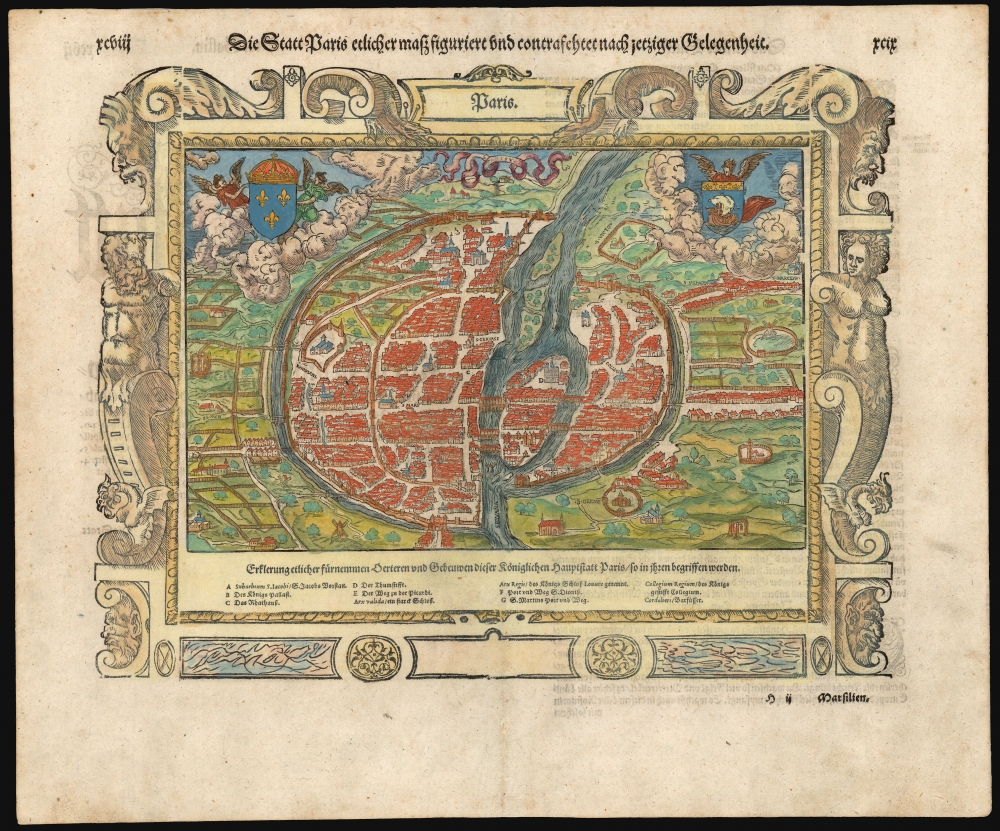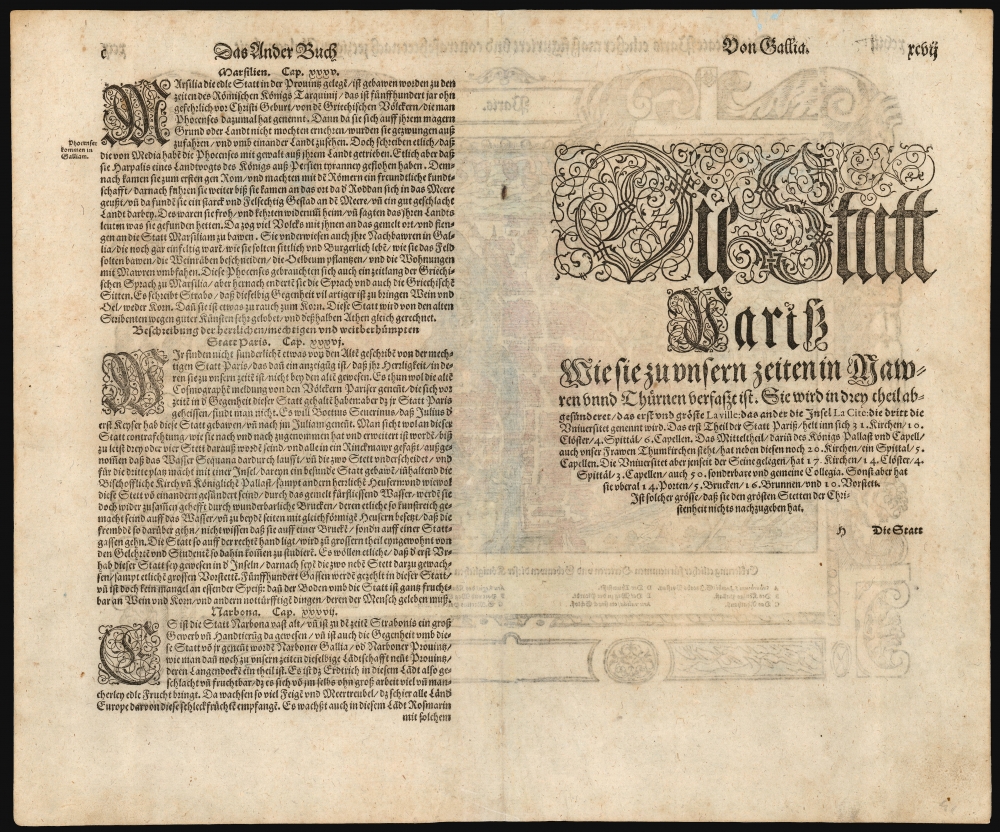This item has been sold, but you can get on the Waitlist to be notified if another example becomes available, or purchase a digital scan.
1572 / 1592 Münster / Petri Plan of Paris
Paris-munster-1572
Title
1572 (undated) 10.25 x 13 in (26.035 x 33.02 cm)
Description
A Closer Look
It presents the walled city oriented to the southeast, centered on the Île de la Cité, and bisected by the Seine. A legend keyed with letters identifies eight specific structures, including the Royal Palace and the Cathedral of Notre Dame. The arms of the city are displayed at the upper right, while the royal fleurs de lis appear at the upper left. A decorative border surrounds the whole.The Source Map: the 'Plan Premier'
This map is derived from a manuscript map of Paris known as the Plan Premier or 'First Plan' of Paris. Compiled between 1523 and 1530, the Plan Premier is said to have measured some 5 x 4 meters and is the source for most 16th-century maps of Paris. The Plan Premier was kept in city offices and updated regularly to reflect urban development. Of the 7 city views of Paris issued in the 16th century, including this map, its 1550 precursor, and the contemporaneous Braun and Hogenberg view, all are derived from the Plan Premier. Curiously, the Plan Premier went missing in the late 16th century, so this and the other views are the only surviving record of this great map.Publication History and Census
This woodcut first appeared in Münster's Cosmographia in 1572, when it replaced the 1550 block cut by Hans Rudolf Deutsch. The present block was engraved for Lyon printer Jean d'Ogerolles in and around 1552 and passed between various publishers before coming to Heinrich Petri at some point after 1564. From 1572 onwards, this block appears in all editions of Cosmographia except for the 1575 Italian edition, which was compiled from sheets surviving from the 1558 Italian edition. This example of the map corresponds to the 1592 German edition. The individual view appears in two citations in OCLC, but it appears on the market from time to time.CartographerS
Sebastian Münster (January 20, 1488 - May 26, 1552), was a German cartographer, cosmographer, Hebrew scholar and humanist. He was born at Ingelheim near Mainz, the son of Andreas Munster. He completed his studies at the Eberhard-Karls-Universität Tübingen in 1518, after which he was appointed to the University of Basel in 1527. As Professor of Hebrew, he edited the Hebrew Bible, accompanied by a Latin translation. In 1540 he published a Latin edition of Ptolemy's Geographia, which presented the ancient cartographer's 2nd century geographical data supplemented systematically with maps of the modern world. This was followed by what can be considered his principal work, the Cosmographia. First issued in 1544, this was the earliest German description of the modern world. It would become the go-to book for any literate layperson who wished to know about anywhere that was further than a day's journey from home. In preparation for his work on Cosmographia, Münster reached out to humanists around Europe and especially within the Holy Roman Empire, enlisting colleagues to provide him with up-to-date maps and views of their countries and cities, with the result that the book contains a disproportionate number of maps providing the first modern depictions of the areas they depict. Münster, as a religious man, was not producing a travel guide. Just as his work in ancient languages was intended to provide his students with as direct a connection as possible to scriptural revelation, his object in producing Cosmographia was to provide the reader with a description of all of creation: a further means of gaining revelation. The book, unsurprisingly, proved popular and was reissued in numerous editions and languages including Latin, French, Italian, and Czech. The last German edition was published in 1628, long after Münster's death of the plague in 1552. Cosmographia was one of the most successful and popular books of the 16th century, passing through 24 editions between 1544 and 1628. This success was due in part to its fascinating woodcuts (some by Hans Holbein the Younger, Urs Graf, Hans Rudolph Manuel Deutsch, and David Kandel). Münster's work was highly influential in reviving classical geography in 16th century Europe, and providing the intellectual foundations for the production of later compilations of cartographic work, such as Ortelius' Theatrum Orbis Terrarum Münster's output includes a small format 1536 map of Europe; the 1532 Grynaeus map of the world is also attributed to him. His non-geographical output includes Dictionarium trilingue in Latin, Greek, and Hebrew, and his 1537 Hebrew Gospel of Matthew. Most of Munster's work was published by his stepson, Heinrich Petri (Henricus Petrus), and his son Sebastian Henric Petri. More by this mapmaker...
Heinrich Petri (1508 - 1579) and his son Sebastian Henric Petri (1545 – 1627) were printers based in Basel, Switzerland. Heinrich was the son of the printer Adam Petri and Anna Selber. After Adam died in 1527, Anna married the humanist and geographer Sebastian Münster - one of Adam's collaborators. Sebastian contracted his stepson, Henricus Petri (Petrus), to print editions of his wildly popular Cosmographia. Later Petri, brought his son, Sebastian Henric Petri, into the family business. Their firm was known as the Officina Henricpetrina. In addition to the Cosmographia, they also published a number of other seminal works including the 1566 second edition of Nicolaus Copernicus's De Revolutionibus Orbium Coelestium and Georg Joachim Rheticus's Narratio. Learn More...




